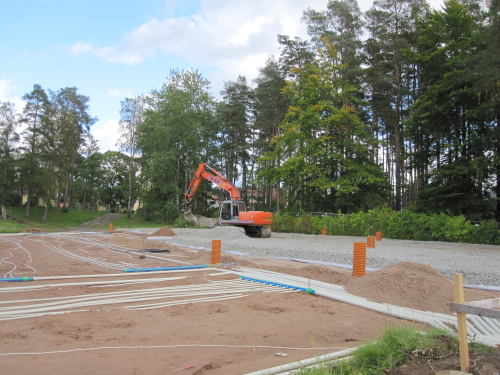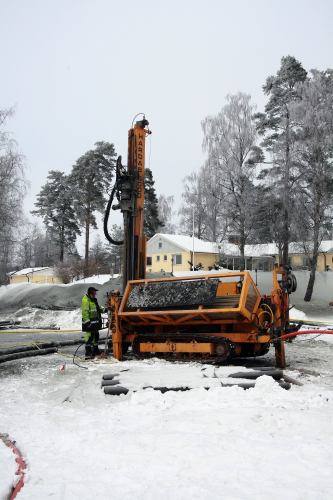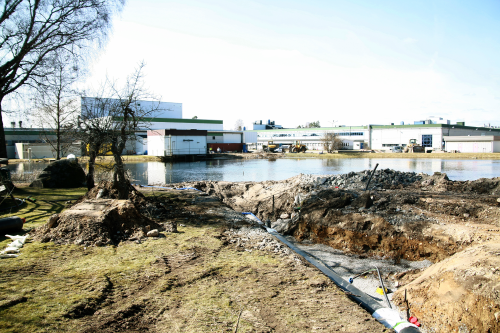


Xylem's largest manufacturing plant, located in Emmaboda in southern Sweden, is a cutting-edge facility, producing 150,000 Flygt brand submersible pumps and mixers annually. Home to Europe's most advanced foundry for casting complex geometric shapes and running 4,000 hours per year, the plant handles the entire production flow, from molten metal to finished products. This results in the generation of significant excess heat.
Most of the heat generated at the plant is from the foundry, directly from cooling melting furnaces, and indirectly from the ventilation system and a water basin used for cooling. Excess heat also arises from performance testing, induction hardening and data centre servers. Sustainability and efficiency are at the core of Xylem's business and in 2009 the company undertook a project to harness this valuable resource.
Intelligent monitoring
Xylem worked with a number of partners to construct a high temperature borehole thermal energy storage (HT-BTES) system at the factory, allowing excess energy to be stored in boreholes during the summer period and reused during winter months to heat the facility.
The HT-BTES system consists of 140 boreholes, 150 m deep. Each of the boreholes is fitted with a high efficiency coaxial heat exchanger, enabling the system to be charged with 3.8 million kilowatts per hour (kWh) during the summer, of which 2.6 million kWh is recovered for indoor heating in winter. The system media is groundwater and there are no added chemicals. Surplus heat can also be stored and reused during winter; excess heat produced during the daytime is stored for reuse in the evenings and at weekends.
The HT-BTES system's intelligent monitoring mechanism, featuring temperature and pressure recorders, is designed to optimise storage by reversing the heat flow direction depending on the mode of operation, charging or discharging the stored heat as required. Information is recorded and transmitted to the central energy control system at the facility, enabling the operators to analyse the data and easily identify any inefficiencies or irregularities.
Construction
The construction of the HT-BTES system has yielded an array of benefits since its installation in 2009, with excess heat now being used for a variety of processes at the plant. The temperature of the bedrock at the facility has increased from 8 degrees Celsius in 2010 to approximately 41°C in 2014. The total energy purchased to heat the facility in 2010 was 7,563 MWh. In 2013 the facility saved 3,500 MWh as a result of the HT-BTES system and associated heat pumps and in 2014 5,100 MWh was saved. During 2013 successful extractions of approximately 40,000 kWh were made while in 2014 100,000 kWh was extracted.
The energy storage system has contributed to increased process stability through more efficient cooling systems. Heat pumps are now used to deliver a fixed low cooling temperature in contrast to the old system which relied on municipal water or external air. Some processes and systems, such as computer server halls; drying zones in painting processes; cooling of air compressor rooms and pump testing basins, which were not included under the original scope of the project, have since been integrated into the energy system.
The reuse of this surplus heat also reduces the facility's use of fossil fuels, thereby lowering greenhouse gas emissions, and diminishes the requirement for water or air for cooling during manufacturing. In addition, the system creates an enhanced working environment as excess heat is channelled out of the workshops.
Recovery of waste
At the Xylem plant, the recovery of waste heat used for indoor heating has increased from 16% in 1998 to 55% in 2009. With the HT-BTES in full operation, this figure is expected to reach 80% or more. Furthermore, in 2015 it will lead to a reduction in purchased energy of about 2,600,000 kWh/year, equivalent to about 8.81 tonnes of carbon dioxide per year.
This innovative system not only provides for more sustainable use of energy at the manufacturing plant but also supports more efficient industrial production. The system has a calculated life span of 30 years. As the need for industrial or supporting processes at the Emmaboda plant increases, these processes can be connected to the HT-BTES with the potential to save 11 megawatt hours per year.
In 2014, the HT-BTES system project was nominated for the EU´s ‘Sustainable Energy Europe Award’ competition and made it to the finals.


